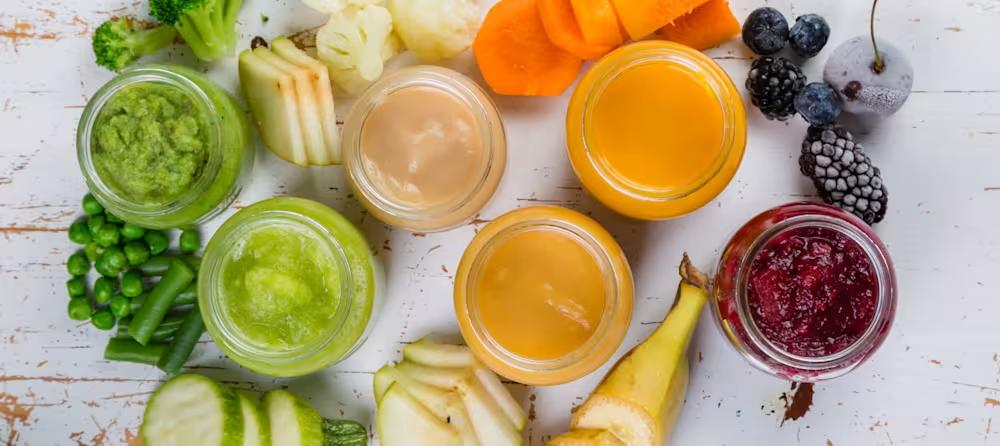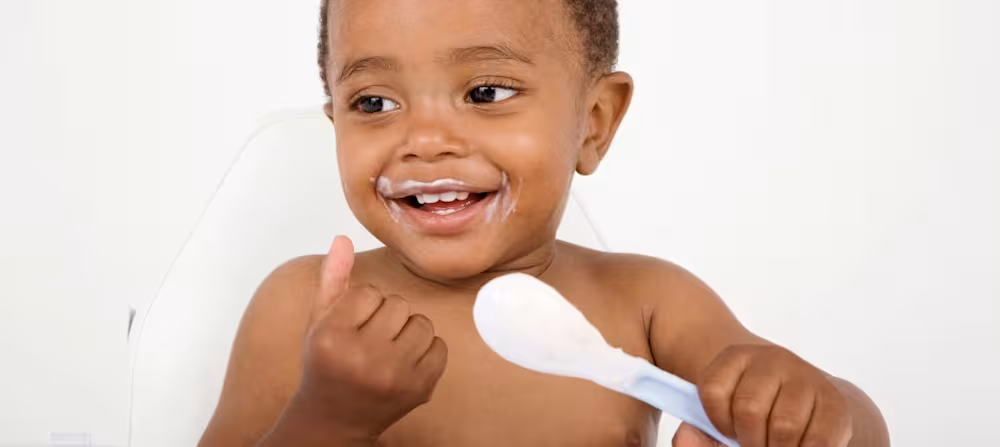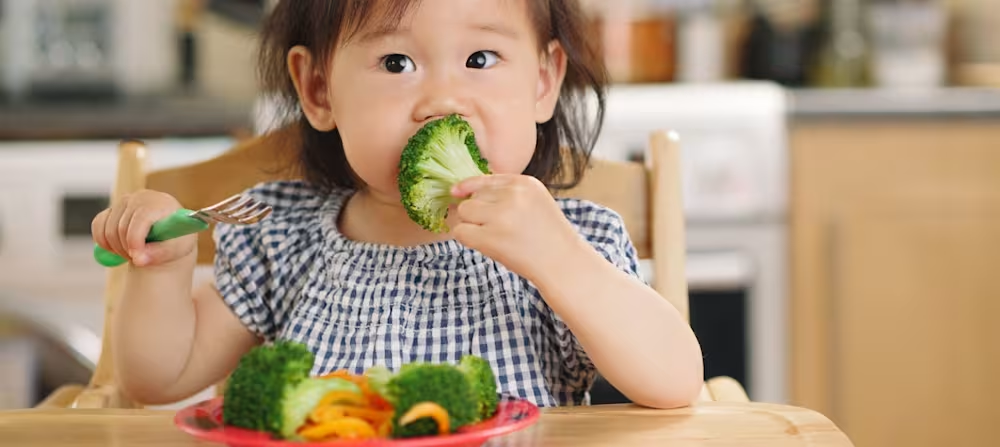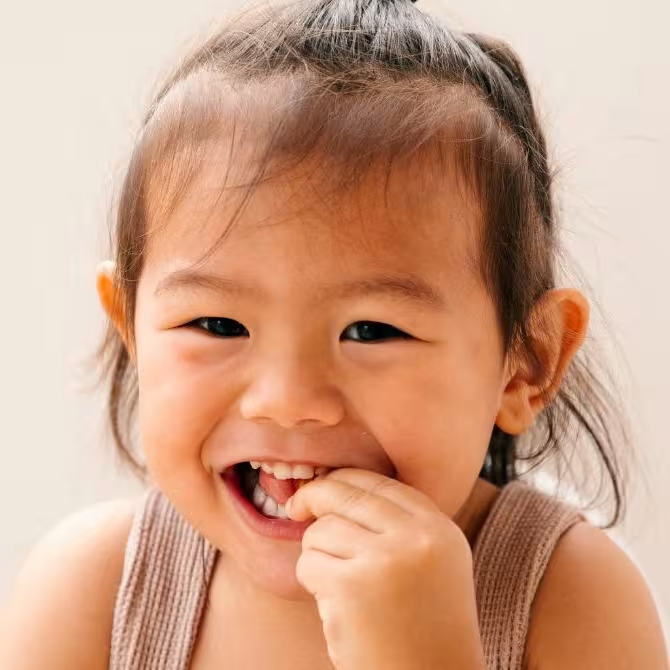Purees: A complete guide to first foods
Updated Dec 05, 2025

For many parents, when they think about baby food, they’re thinking purees. Purees are often the first foods served to babies, and now there are more options than ever before. Store-bought, homemade, or home delivery, when it comes to purees, every family is sure to find a plan that works for them.
What are purees?
Purees are foods with a smooth, soft texture and, according to the Academy of Nutrition and Dietetics [], are traditionally served as babies’ first solid foods. You can make a puree out of just about anything, but often they’re made of fruits, vegetables, meats, or whole grains. Purees can be purchased at the grocery store or made at home in a variety of textures and flavors to meet your baby’s needs.
When to start purees?
You should avoid giving your baby purees before 4 months of age, as this has been associated with certain risks []. Most babies are ready to start pureed solids at around 6 months old, once they meet all the following signs of readiness []:
Sits up independently with good head and neck control
Loss of tongue thrust reflex
Brings toys or other objects to their mouth
Shows an interest in table foods
Weighs double their birth weight
At around 9 months, most babies should transition to soft table foods to continue developing their feeding skills, integrate more with family meals, and help avoid difficulties down the road.
How to start purees
Starting purees is exciting, and most caregivers really look forward to it, but it can feel a bit daunting, too. After you’ve assessed your baby’s signs of readiness, follow the steps below to make the transition smoother.
Begin slowly
Introducing solid food is a gradual process, and the majority of your baby’s nutrition will still come from breast milk or formula until they are approaching their first birthday. Begin by serving one small solid meal a day, increasing the amount of food and number of meals slowly over time.
When introducing new foods, start with one at a time with a few days to a week in between introductions. First foods should contain one ingredient and not include additives such as salt, sugar, or spices.
Set up a safe place for mealtime
Make sure your baby is seated upright in a highchair for all meals to reduce the risk of choking []. Create a space where you can easily watch them, and remember to never leave them alone while they are eating — or in a highchair at all, for that matter.
Learn hunger and fullness cues
Even though your baby can’t talk yet, they can still let you know [] when they’re hungry for more food and when they’re full. A hungry baby will open their mouth as the spoon approaches and show interest in the meal. A full baby will keep their mouth closed or turn their head when the spoon approaches and seem distracted or uninterested in the meal. Instead of simply feeding the whole container of food, do your best to follow their cues to avoid feeding issues later on.
Advance textures appropriately
Did you know purees come in different textures? Once your baby masters completely smooth purees, it’s time to advance them to purees with lumps and mashed foods. Continuously advancing textures when one level is mastered helps your baby develop the skills they need to eat table foods, which is the ultimate goal of weaning!
Top 5 benefits of purees
1. Convenient and plentiful food options
Baby food options are practically endless these days! Grocery stores are stocked with a variety of food blends and textures, and some companies will deliver them right to your door. All of these options are ready-to-serve, which can be nice for busy days and when you are out and about. You can also make homemade baby food, which takes a little more time, but it allows you to completely choose what’s in the food.
2. Easily track how much baby is eating
Watching for your baby’s hunger and fullness cues are the best indicators to judge how much your baby should be eating. However, many parents feel more at ease when they can quantify the amount. Labels on baby food paired with spoon feeding make it relatively easy to keep track, even though much of it ends up on their face at first!
3. Safely serve high-priority, nutrient-rich foods
Foods rich in iron, zinc, and protein should be prioritized as your baby begins to eat solids. It’s a popular misconception that these nutrients only come from animal foods such as meat, eggs, and fish. However, many fruits and vegetables contain these nutrients and also provide necessary [] dietary fiber, anti-inflammatory compounds, and antioxidants.
Some foods can be difficult for young babies to chew, but serving them in a pureed form is safe and much easier.
4. Less mess and food waste than other weaning methods
No matter how you do it, learning to eat is messy, and food tends to get everywhere! Babies are still developing the coordination and strength to get food into their mouth, and they love to play with their food. However, using purees and spoon-feeding at the beginning may help eliminate some of the mess and food waste that may be associated with .
5. More support from family members or caregivers
Feeding purees is a well-understood way to feed your baby. In fact, it’s likely how your parents fed you, so if you are looking for help and support from grandparents, you’ll be in luck! Additionally, many childcare providers prefer serving purees, and following the same feeding method can be easier for some parents and less confusing for babies.
Are there any risks with purees?
Baby may get stuck on a texture
Many parents don’t realize that feeding purees is done over a relatively short period of time. By 9 months of age, most babies should be transitioned over to soft table food. Continuously advancing textures helps to ensure your baby doesn’t get stuck on one texture and reduces feeding issues [] later on.
Potential heavy metal exposure
Reports [] of heavy metals in commercial baby foods are unfortunately not new. While it can be scary to read this type of news as a parent, there are steps you can take to reduce exposure. Some crops, such as rice [] and root vegetables, naturally contain heavy metals found in the soil they were grown in, meaning we can’t completely avoid them. To reduce exposure, lower the use of rice products if possible [] and offer your baby a variety of foods, such as the following:
made from grains other than rice, such as oats
Snacks made at home using whole ingredients (instead of prepackaged snacks)
Apples, avocados, bananas, and other fruits (but skip the fruit juice)
Best puree foods: Top purees to start for baby
Fruit and vegetable purees tend to be the most popular, but babies need a variety of different foods even when they are just starting solids. While the majority of nutrition will still come from breast milk or formula, nutrient-dense solid foods should provide additional sources of iron, protein, fiber, and healthy fats.
Note that store-bought purees are often categorized by level:
First foods: contain one ingredient; pureed very smoothly
Second foods: contain two or more ingredients; may be a little thicker
Third foods: combinations of foods with a texture that requires a bit of chewing
Iron-rich foods
Iron’s main job is to carry oxygen throughout the body, and this is especially important during times of rapid growth, such as infancy. In fact, iron needs are highest at this stage of life. Look for or make purees containing the following foods to help meet your baby’s iron needs []:
Meat (beef, pork)
Poultry (chicken, turkey)
Eggs
Beans
Lentils
Tofu
Fortified breakfast cereal
Keep in mind that iron absorption is best when the food is combined with vitamin C-containing foods — such as citrus, strawberries, kiwi, tomato, and dark green vegetables — in the same meal.
Protein-rich foods
Protein also supports the rapid growth and development that happens during infancy. It helps build muscle and other body tissues, forms enzymes that facilitate important functions in the body such as digestion, and supports the immune system. Fortunately, breast milk and formula are both protein-rich, which means you can emphasize other nutrients while your baby’s diet is made up primarily of one of these. However, when wanting to provide additional protein in the first year, look for or make purees containing the following foods:
Meat (beef, pork)
Poultry (chicken, turkey)
Fish
Beans
Lentils
Tofu
Cheese
Yogurt
Nut butter (mix thinly into other purees)
Whole grains
Green, leafy vegetables
Fat-rich foods
Fat provides much-needed energy for babies and supports healthy growth and development of the brain and central nervous system. Certain types of fats, such as omega-3 fatty acids, are essential, meaning they can only be gotten through food and are not made in the body. Look for or make purees containing the following foods to help meet your baby’s fat needs:
Avocado
Fish
Full-fat yogurt
Olive oil
Butter
Nut butter (always mix thinly to reduce choking risk)
Chia seeds
Ground flaxseeds
Fruits & vegetables
Fruits and vegetables are great foods to introduce to your baby, of course, and they should be emphasized for the best nutrition for all of us! They provide important vitamins, fiber, antioxidants, and minerals and introduce babies to a wide range of flavors, which may help them accept more foods later on.
Fiber is crucial for baby’s digestion. Many of the processed baby foods (like crackers or boxed foods) and all animal-based foods are deficient in fiber. Choose various fruits and veggies such as:
Carrots
Broccoli
Butternut squash
Cauliflower
Cucumbers
Zucchini
Tomatoes
Sweet potatoes
Potatoes
Pumpkin
Plums
Peaches
Apples
Kiwi
Avocado
Banana
Raspberries
Blueberries
Strawberries
Pears
Grapes
Cantaloupe
Watermelon
Cherries
Mango
Printable baby food charts for purees
The charts below serve as a reference and starting point for beginning purees. Feel empowered to switch them up to find what works for your family! Remember to take it slow and to advance textures as your baby masters them.
6 month puree food chart
At 6 months, your baby should begin eating about one solid food meal a day. Food should be purchased or blended into a smooth puree with no lumps.
If blending your own baby food [], avoid additives such as salt, sugar, and spices. When pureeing food while preparing the family’s dinner, it’s best to remove the baby’s share to puree before seasoning the remainder to the rest of the family’s liking. You can spoon-feed your baby, offer them a preloaded spoon, or do a mixture of both.
Remember that breast milk or formula is the primary source of nutrition at this age, and the solid meal should be offered after a feeding — almost like dessert. Babies will only take a spoonful or two of pureed food in the beginning, so don't expect them to finish a jar! To avoid food waste when making your own pureed food, you can freeze it in ice cube trays and then place it in plastic bags that can be stored in the freezer once frozen.
7 month puree food chart
At 7 months, your baby may have advanced to two solid food meals a day. Food should be purchased or blended into a lumpy puree. You can spoon-feed your baby, offer them a preloaded spoon, or do a mixture of both.
8 month puree food chart
By 8 months, your baby will probably be eating two solid food meals a day. Food should be a mashed texture with small pieces of soft food. You can spoon-feed your baby, offer them a preloaded spoon, or do a mixture of both. Around this age, many babies will have started to grasp objects and may be interested in self-feeding. Offer small pieces of soft table foods as you feel comfortable — by 9 months, your baby should be finger feeding almost everything.
9+ month puree food chart
At 9 months, your baby may have added a third solid food meal each day. Your baby should be finger feeding by this time and eating soft table foods in order to develop proper feeding skills and oral muscle coordination.
Note: Sometimes babies start eating less with this change. Resist the urge to revert back to all purees. It will take time for them to learn and explore food, but as they approach 12 months of age, they should be getting most of their nutrition from solid food.
Takeaway:
Start purees when your baby is ready: Most babies are ready around 6 months, once they meet all signs of readiness. Avoid starting before 4 months due to increased risks.
Advance textures early and often: Purees are a short phase. Gradually move from smooth to lumpy to soft table foods by around 9 months to support feeding skills and avoid texture-related challenges.
Follow your baby’s cues: Watch for hunger and fullness signals rather than aiming for a certain amount. This supports healthy eating habits and helps prevent feeding struggles later on.
Prioritize nutrient-rich foods: Iron, protein, healthy fats, fruits, and vegetables can all be safely offered as purees. Aim for variety to support nutrition and reduce exposure from heavy-metal-prone foods like rice.
Safety and setup matter: Always feed your baby upright in a highchair and stay within arm’s reach. Introduce one new food at a time and keep the environment calm, consistent, and supervised.
Share article:
Note: The content on this site is for informational purposes only and should not replace medical advice from your doctor, pediatrician, or medical professional. If you have questions or concerns, you should contact a medical professional.
12 Sources
Share article:











